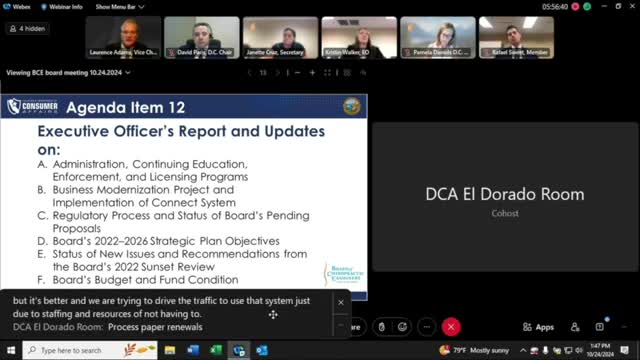Regulatory board faces staffing crisis as proposals stall amid growing frustrations
October 24, 2024 | Board of Chiropractic Examiners, Other State Agencies, Executive, California
This article was created by AI summarizing key points discussed. AI makes mistakes, so for full details and context, please refer to the video of the full meeting. Please report any errors so we can fix them. Report an error »

In a recent meeting of the Board of Chiropractic Examiners, the atmosphere was charged with a sense of urgency and concern as board members addressed pressing issues affecting the chiropractic community in California. The discussions highlighted the challenges posed by a hiring freeze and the backlog of proposals that have left many practitioners feeling frustrated and unsupported.
Dr. Daniels, a board member, voiced his apprehensions about the current state of continuing education (CE) proposals, which he described as a top priority yet mired in delays. He expressed his dissatisfaction with the regulatory process, noting that despite a vote in April 2023 aimed at streamlining operations, the reality has been quite the opposite. "It really feels like it's becoming a hardship," he lamented, emphasizing the impact on both licensees and the public they serve.
The board's inability to fill vacant positions has compounded the issue, leading to a significant backlog of 20 proposals that remain unaddressed. Dr. Daniels articulated a deep concern for the well-being of practitioners who are already under stress, stating that the current situation could lead to a decline in the quality of care provided to patients. "If we are stressing our licensees... people just don't do as good of a job," he warned.
He also reflected on his own commitment to professional development, despite not being required to complete CE courses. His dedication underscores the importance of ongoing education in maintaining high standards within the profession. However, he pointed out that the reduction in available classes due to the regulatory limbo is detrimental to those who do need them.
The meeting also touched on the broader implications of these challenges for small business owners in the chiropractic field. Dr. Daniels highlighted the need for quick decision-making and adaptability in a profession that often lacks the safety nets found in traditional employment, such as paid vacation or retirement plans. "We have to adapt very quickly," he stated, urging the board to recognize the urgency of the situation.
As the meeting progressed, it became clear that both sides of the regulatory process—the board and the practitioners—must work collaboratively to navigate these challenges. Dr. Daniels called for mutual respect and understanding, emphasizing that both perspectives are valid and essential for moving forward.
The discussions at this meeting reflect a critical moment for the Board of Chiropractic Examiners as they strive to balance regulatory responsibilities with the needs of the chiropractic community. With significant proposals pending and a pressing need for reform, the board faces the challenge of restoring confidence among practitioners while ensuring the public continues to receive quality care. The path ahead remains uncertain, but the commitment to addressing these issues is evident among board members.
Dr. Daniels, a board member, voiced his apprehensions about the current state of continuing education (CE) proposals, which he described as a top priority yet mired in delays. He expressed his dissatisfaction with the regulatory process, noting that despite a vote in April 2023 aimed at streamlining operations, the reality has been quite the opposite. "It really feels like it's becoming a hardship," he lamented, emphasizing the impact on both licensees and the public they serve.
The board's inability to fill vacant positions has compounded the issue, leading to a significant backlog of 20 proposals that remain unaddressed. Dr. Daniels articulated a deep concern for the well-being of practitioners who are already under stress, stating that the current situation could lead to a decline in the quality of care provided to patients. "If we are stressing our licensees... people just don't do as good of a job," he warned.
He also reflected on his own commitment to professional development, despite not being required to complete CE courses. His dedication underscores the importance of ongoing education in maintaining high standards within the profession. However, he pointed out that the reduction in available classes due to the regulatory limbo is detrimental to those who do need them.
The meeting also touched on the broader implications of these challenges for small business owners in the chiropractic field. Dr. Daniels highlighted the need for quick decision-making and adaptability in a profession that often lacks the safety nets found in traditional employment, such as paid vacation or retirement plans. "We have to adapt very quickly," he stated, urging the board to recognize the urgency of the situation.
As the meeting progressed, it became clear that both sides of the regulatory process—the board and the practitioners—must work collaboratively to navigate these challenges. Dr. Daniels called for mutual respect and understanding, emphasizing that both perspectives are valid and essential for moving forward.
The discussions at this meeting reflect a critical moment for the Board of Chiropractic Examiners as they strive to balance regulatory responsibilities with the needs of the chiropractic community. With significant proposals pending and a pressing need for reform, the board faces the challenge of restoring confidence among practitioners while ensuring the public continues to receive quality care. The path ahead remains uncertain, but the commitment to addressing these issues is evident among board members.
View full meeting
This article is based on a recent meeting—watch the full video and explore the complete transcript for deeper insights into the discussion.
View full meeting
